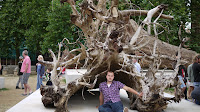
The garden tidy up included: weeding, clearing leaves and other debris, shaping of shrubs, cutting down and dividing herbaceous plants, shaping evergreen plants, pruning fruit trees, planting winter bedding and bulbs, turning over the soil.

A glue plastic is tied to the bottom of the tree will stop 90% of pest trying to climb the tree. This is a good practice and is usually used to fruit trees and helps them to produce better fruits without using any pesticide chemicals.

Pruning of fruit trees such as apples and pears is done in November, it is important that this is done correctly so the plants grow health and produce better fruits. There is some fruit trees such as cherries and plums (prunus spp) that usually are pruned after flowering to prevent silver leaf disease.

There are some perennial plants that like a really gently pruning, this group includes most of acid loving plants such as pieris, rhododendron and magnolias.

Two eunoumus spp planted together and shaped as a single one, looks nice doesn't it?
Me shaping plants such as sweet bay, forsythia, abelia etc. all timber posts in this garden are used to help the owner (disabled lady) move around and enjoy her garden.
Gardener or Landscape Architect?
When people ask us about our profession, we tell them that we are Landscape architects. Sometimes they think that this is type of gardening design and landscape. Well, we don't get impresed when we are called 'gardener'. We know that a Landscape Architect is more than a gardener or garden designer/landscaper, however we know that we have to collaborate with this category of people when designing.
It is important for us to know about plants, landscape materials and maintenance. I believe that when designing we should include a maintenance programme for our design. The maintenance programme and average yearly maintenance cost. This can make the design look good at all time and keep its values for long.
I hope all this will encourage Landscape Architects to learn more about plants, role in design and maintenace.










































